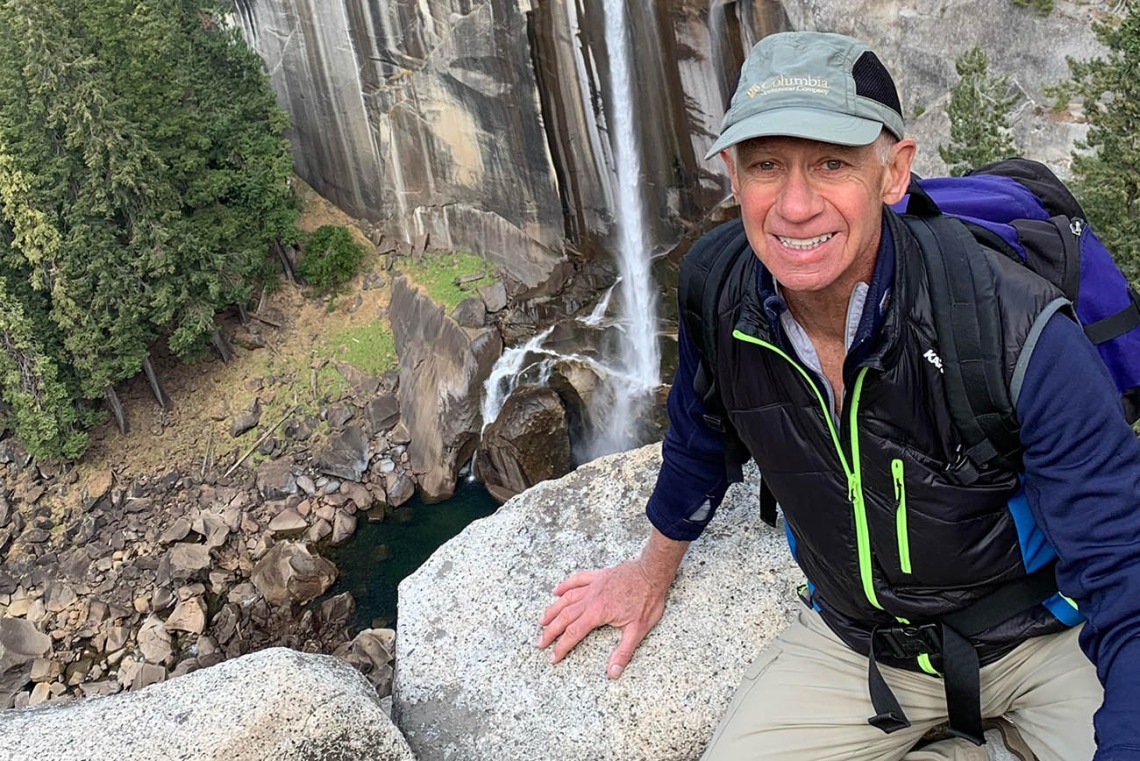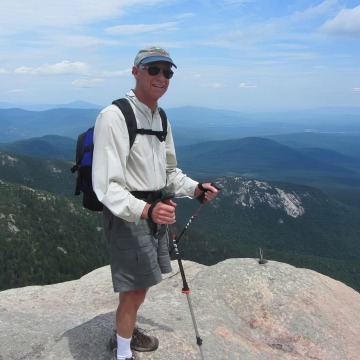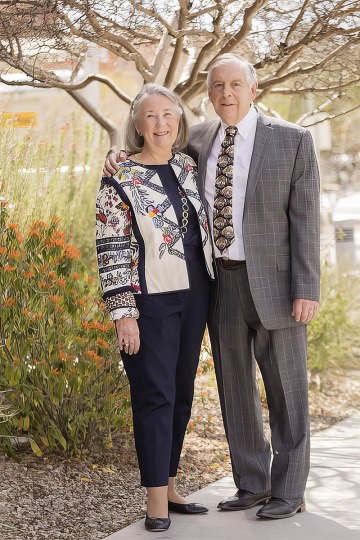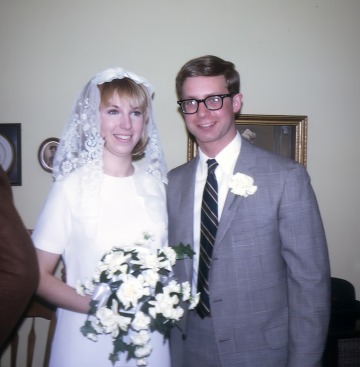A legacy of hope continues through CAMI
Bruce and Patricia Bartlett’s endowment to catalyze transformative cancer medicine may prove the ultimate ROI from legendary investor George A. Vanderheiden.

A generous gift made by Bruce and Patricia Bartlett in the name of the late George Vanderheiden (pictured) will fund an endowed chair and future cancer research at the University of Arizona Health Sciences Center for Advanced Molecular and Immunological Therapies.

In the financial world, Vanderheiden was hailed as a brilliant investor for his work at Fidelity Investments. Outside of work, he was an adventurer, world traveler and dedicated philanthropist.
George Vanderheiden was a humble man – not one to talk about his achievements (there were many), not even with his closest confidantes. “You’d never know what he accomplished,” recalled Bruce Bartlett, Vanderheiden’s cousin, though they were as close as brothers. “The only way I’d find out anything was because his mother would tell my mother, who would tell me. Trying to get it from George was like pulling teeth.”
Vanderheiden died last October from a rare form of pancreatic cancer – one that is currently untreatable and for which not even clinical trials offered hope. In the wake of that loss, Bartlett and his wife, Patricia, chose to honor their cousin’s life with a gift to fuel pioneering work that could change the course of human history.
Their $3 million benefaction establishes the George A. Vanderheiden Endowed Chair in Cancer Immunological Research at the Center for Advanced Molecular and Immunological Therapies, or CAMI. CAMI is the University of Arizona Health Sciences’ nascent biomedical research hub charged with tackling some of the world’s most intractable diseases. Its pioneering roadmap has the potential to make cancer, the second-leading cause of death worldwide, not just treatable, but curable. And that’s an investment that long-time fund manager Vanderheiden would no doubt deem blue chip.
The stuff of investing legend
Vanderheiden began working with Fidelity Investments in 1971, not long after earning his Master of Business Administration degree from Boston University. The company had some 200 associates at the time, and Vanderheiden initially opted for the path of financial analyst, unsure he’d do well as a stocks manager. It was, ironically, one of his worst misjudgments in a long and storied career. In fact, when Vanderheiden did become a fund manager, he ultimately proved to have a rare genius for investing.
“Those who have been successful have an even greater responsibility to make an impact with our time, talents and resources.”
George A. Vanderheiden
Though an adventurer outside of work – he’d take his three daughters on whitewater rafting trips, safaris in Africa and climbing expeditions in Europe – behind the desk, he was known for GARP investing: Growth at Reasonable Prices. It was a moderate strategy, at times earning him the label “contrarian,” but Vanderheiden was competitive at heart. He played to win, and for a span of 10 years, his investments outperformed those of every other fund manager in the country.
In his 19 years leading Fidelity’s Destiny I fund, Vanderheiden achieved total returns of 2,781%, compared to 1,865% of the S&P 500 Index over the same period. For decades he calmly and steadily built a legacy that earned doffed caps across the investing world, not as a “wolf of Wall Street,” but as someone coworkers described as “so cooperative” and “easy to work with.” He loved honest success – his own or someone else’s – never caving to a zero-sum mentality. He mentored those around them with a genuine desire to help, and it made him all the better. In the words of his colleague, famed fund manager Peter Lynch: “Quite simply, George is one of the best investors of all time.”
The promise of precision medicine
“Giving is personal,” Patricia Bartlett said, reflecting on the origins of their philanthropy at the University of Arizona. She and Bruce, both former teachers, began supporting education after their son, Benjamin Bartlett, graduated from UArizona in 2010.

Bruce and Patricia Bartlett's gift of $3 million establishes an endowed chair in honor of their late cousin, George A. Vanderheiden, in the developing Center for Advanced Molecular and Immunological Therapies at the University of Arizona Health Sciences.
It was those early conversations, exploring the dearth of medical diagnoses for youth with learning and attention differences, that the Bartletts first connected with Michael D. Dake, MD, senior vice president of the University of Arizona Health Sciences, who is leading the development of CAMI.
Sadly, the Barletts’ connection to CAMI’s work was personal even before Vanderheiden’s illness and death. Bruce’s father and one of his brothers died of cancer. Patricia’s brother, also deceased, received hormone therapy that dramatically improved quality of life in his final years. Hormone treatments alter the cellular processes of disease and are one class of the molecular therapies at the heart of CAMI’s mission, built on growing evidence that cell- and gene-based interventions capitalizing on the body’s innate systems offer the best countermeasures for fighting disease.
Immunotherapy, the other focus of CAMI, is one of today’s most promising approaches to cancer treatment – one with the potential to bypass the side effects of even gold-standard interventions that too often compromise long-term health and wellness. Classic immunotherapies such as vaccines are already being tested for certain cancers, and CAMI scientists could one day identify biomarkers that help determine highly precise molecular and immunotherapy interventions tailored to individual patients’ unique biological makeups and needs.
A commitment to giving back
The Bartletts, like Vanderheiden, didn’t grow up with money. In college, Bruce and Vanderheiden advertised in the town paper to paint, wash windows and do other odd jobs for extra cash. Bruce got through college on student loans, as did Patricia, who worked her way through school as a waitress. The two became teachers, along with Patricia’s best friend, Sharon, who made a fourth for double-dating and eventually became Vanderheiden’s wife. Each couple had three children, and many summers were spent with all of them together at the Vanderheidens’ house on Lake Winnipesaukee. Such is the story of how two families became one.
The families shared a close-held belief that shaped their trajectories, as well as the lives of many more. “Since there is nothing we can take with us from this life,” Vanderheiden once said, “we should try to leave behind as much as possible. Those who have been successful have an even greater responsibility to make an impact with our time, talents and resources.”

Sharon and George Vanderheiden were married in 1968 and remained close to the Bartletts as they raised their families.
Vanderheiden took that responsibility seriously. His wife recounted how he would read a newspaper story about someone in need and just send them money, especially if doing so helped a child. Vanderheiden’s passion for pickleball, sparked during winters in Arizona, gave rise to courts across the town of Wolfeboro, New Hampshire, where the Vanderheidens lived. Regional charter schools are $14 million stronger thanks to the Vanderheidens’ commitment to education. The causes they supported reveal a generosity and compassion moved by so much need in the world: mortgage-free homes for families of fallen military service members and first responders; adaptive sports for people with disabilities; safety and wellness programs for pregnant women struggling with addiction; youth education-to-employment programs in Kenya. The list goes on, and these are only the Vanderheidens’ direct acts of philanthropy.
“In an indirect way, he probably helped a few million people with their retirement and quality of life,” Bruce noted. It’s an idea also expressed by one of Vanderheiden’s colleagues in reply to an article celebrating his legendary work: “We all want to leave a legacy. George probably had a family and an amazing personal legacy, but he also has a legacy for thousands of people he will never meet.”
Indeed, it’s impossible to know how many lives have been touched by the ripples of Vanderheiden’s investing acumen. How many families, confident in the health of their growing savings, could pay for their kids to go to college? How many food banks, animal shelters and fraternal orders of police benefited with small-scale donations from households he’d helped make financially secure? How do we tally the magnitude of that impact over a 30-year career and moving forward?
A final gift
Two months before his death, Vanderheiden wrote to Bruce and Patricia about his decision to forgo another round of chemotherapy. The treatment, which proved ineffective, damaged organs, fogged his brain, and wracked his body with pain, chills, cramps, fatigue and a host of other ailments – the very complications of treatment that might someday be eradicated by research under the CAMI chair that now bears his name.
“My appetite has returned, and food is now enjoyable again,” Vanderheiden shared. “I am no longer staring down a dark rabbit hole, but instead I’m looking with joy at the blue waters of Lake Winnie. I am not saying stupid things and forgetting friends’ names, but instead staring into their eyes and seeing caring. This clarity of thought reminds me that people are far more important than any other thing in your life.”
It was one last gift of the mentoring that came naturally to Vanderheiden: sharing what he was learning, and in the process, giving the people he loved a small shelter of peace against the loss they were facing. That letter also included a challenge to himself – a kind of echo rippling forward from the beginning of his life some 76 years before.
Vanderheiden’s father was serving in WWII on the USS Eagle 56 when the patrol boat sank off the coast of Maine on April 23, 1945. The disaster was blamed on a boiler explosion for more than a half-century before investigations proved it was sunk by a German submarine.
That sub, the U-853, was itself sunk two weeks later by Hedgehog depth charges from the USS Atherton and USS Moberly. The victory was cold comfort for the families who lost loved ones on the Eagle, the Vanderheiden family included. He never got to hold young Vanderheiden, his newborn son.
“My daughter will give birth to her fourth child in a short time, and I want to go out not fighting one of life’s curses, but holding a new life in my arms,” Vanderheiden wrote to Bruce and Patricia in closing his letter. “That is my new goal.”
Vanderheiden met that goal he’d set for himself. Before his death, he held that new life in his arms: just three weeks old, his grandchild and namesake, Georgia.
Contact
Stacy Pigott
Health Sciences Office of Communications
520-539-4152
spigott@arizona.edu

